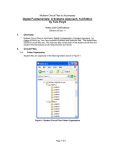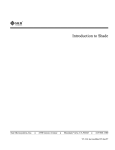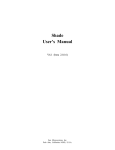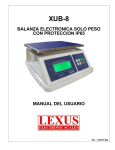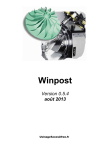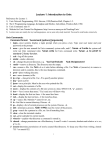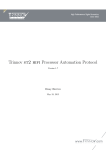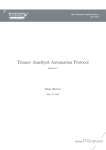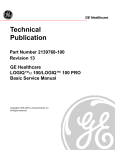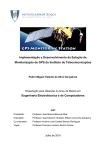Download Shade User`s Manual
Transcript
Shade
User’s Manual
V5.33A
Sun Microsystems Laboratories, Inc.
Mountain View, CA 94043
Copyright 1998 Sun Microsystems, Inc. 901 San Antonio Road, Palo Alto, California 94303, U.S.A. All rights
reserved.
This product or document is protected by copyright and distributed under licenses restricting its use, copying,
distribution, and decompilation. No part of this product or document may be reproduced in any form by any
means without prior written authorization of Sun and its licensors, if any.
Parts of the product may be derived from Berkeley BSD systems, licensed from the University of California.
UNIX is a registered trademark in the U.S. and other countries, exclusively licensed through X/Open Company,
Ltd.
Sun, Sun Microsystems, Sun Microelectronics, the Sun Logo, Solaris, and SunOS are trademarks or registered
trademarks of Sun Microsystems, Inc. in the U.S. and other countries.
All SPARC trademarks are used under license and are trademarks or registered trademarks of SPARC International, Inc. in the U.S. and other countries. Products bearing SPARC trademarks are based upon an architecture developed by Sun Microsystems, Inc.
U.S. Government approval required when exporting the product.
RESTRICTED RIGHTS: Use, duplication, or disclosure by the U.S. Govt is subject to restrictions of FAR
52.227-14(g) (2)(6/87) and FAR 52.227-19(6/87), or DFAR 252.227-7015 (b)(6/95) and DFAR 227.7202-3(a).
DOCUMENTATION IS PROVIDED "AS IS" AND ALL EXPRESS OR IMPLIED CONDITIONS,
REPRESENTATIONS AND WARRANTIES, INCLUDING ANY IMPLIED WARRANTY OF MERCHANTABILITY, FITNESS FOR A PARTICULAR PURPOSE OR NON-INFRINGEMENT, ARE DISCLAIMED,
EXCEPT TO THE EXTENT THAT SUCH DISCLAIMERS ARE HELD TO BE LEGALLY INVALID.
TABLE OF CONTENTS
1. Commands and Application Programs
intro
. . . . . . . . . . . . . . . . . . . . . . . . . . introduction to Shade analyzers
cachesim5
. . . . . . . . . . . . . . . . . . . . . . . . . . . . . . cache simulator
icount
. . . . . . . . . . . . . . . . . . . . . . . . . . . count executed instructions
ifreq
. . . . . . . . . . . . . . . . . . . . . . . . . . . opcode execution frequency
pairs . . . . . . . . . . . . . . . . . . . . . . . . . . . . . instruction pairs analyzer
spixcounts
. . . . . . . . . . . . . . . . . . . . . . . . . . . generate spix counts file
trips
. . . . . . . . . . . . . . . . . . . . . . . . . . . . instruction triplets analyzer
window
. . . . . . . . . . . . . . . . . . . . . . . . . . . register window analyzer
3. Subroutines
intro
. . . . . . . . . . . . . . . . . . . . . . . . . . . introduction to Shade library
appstatus
. . . . . . . . . . . . . . . . . . . . . . . . . get application execution state
io
. . . . . . . . . . . . . . . . . . . . . . . . . . . . . . . . . . application I/O
load
. . . . . . . . . . . . . . . . . . . . . . . . . . . . . load application program
main
. . . . . . . . . . . . . . . . . . . . . . . . . . . . Shade analyzer entry point
mapfd
. . . . . . . . . . . . . . . . . . . . . . . . . . . file descriptor renumbering
memory
. . . . . . . . . . . . . . . . . . . . . . . . application memory base address
rlimit
. . . . . . . . . . . . . . . . . . . . . . . . . . . . application resource limits
run
. . . . . . . . . . . . . . . . . . . . . . . . . . run and trace application program
shell
. . . . . . . . . . . . . . . . . . . . . . . . . . . . . . run application scripts
signal
. . . . . . . . . . . . . . . . . . . . . . . . . . . . send signal to application
splitargs
. . . . . . . . . . . . . . . . . . separate analyzer and application argument lists
trange
. . . . . . . . . . . . . . . . . . . . . . . restrict tracing by instruction address
trctl . . . . . . . . . . . . . . . . . . . . . . . . . . . . . . instruction trace control
Shade
- iii -
26/Jun/97
26/Jun/97
- iv -
Shade
PERMUTED INDEX
shade_bench_memory: application memory base
restrict tracing by instruction
pairs: instruction pairs
trips: instruction triplets
window: register window
shade_splitargs: separate
shade_main: Shade
intro: introduction to Shade
shade_kill_bench: send signal to
shade_splitargs: separate analyzer and
shade_appstatus: get
shade_bench_close:
shade_bench_creat:
shade_bench_dup:
shade_bench_dup2:
shade_bench_fcntl:
shade_bench_ioctl:
shade_bench_open:
shade_bench_memory:
shade_load, shade_loadp: load
shade_run, shade_step: run and trace
shade_bench_getrlimit, shade_bench_setrlimit:
shade_shell, shade_fshell, shade_sshell: run
separate analyzer and application
shade_bench_memory: application memory
cachesim5:
shade_trctl: instruction trace
icount:
shade_unmapfd, shade_unmappedfd: file
shade_main: Shade analyzer
icount: count
ifreq: opcode
shade_appstatus: get application
spixcounts: generate spix counts
shade_unmapfd, shade_unmappedfd:
ifreq: opcode execution
spixcounts:
shade_argtrange: restrict tracing by
pairs:
shade_trctl:
trips:
icount: count executed
intro:
intro:
intro: introduction to Shade
shade_bench_setrlimit: application resource
separate analyzer and application argument
shade_load, shade_loadp:
shade_bench_memory: application
ifreq:
pairs: instruction
window:
shade_unmappedfd: file descriptor
Shade
address. . . . . . . . . . . . . . . . . .
address. /shade_intrange, shade_argtrange:
. .
analyzer.
. . . . . . . . . . . . . . . .
analyzer.
. . . . . . . . . . . . . . . .
analyzer.
. . . . . . . . . . . . . . . .
analyzer and application argument lists. . . . .
analyzer entry point. . . . . . . . . . . . .
analyzers.
. . . . . . . . . . . . . . . .
application. shade_bench_kill,
. . . . . . .
application argument lists.
. . . . . . . . .
application execution state. . . . . . . . . .
application I/O. . . . . . . . . . . . . . .
application I/O. . . . . . . . . . . . . . .
application I/O. . . . . . . . . . . . . . .
application I/O. . . . . . . . . . . . . . .
application I/O. . . . . . . . . . . . . . .
application I/O. . . . . . . . . . . . . . .
application I/O. . . . . . . . . . . . . . .
application memory base address.
. . . . . .
application program. . . . . . . . . . . . .
application program. . . . . . . . . . . . .
application resource limits.
. . . . . . . . .
application scripts.
. . . . . . . . . . . .
argument lists. shade_splitargs: . . . . . . .
base address. . . . . . . . . . . . . . . .
cache simulator.
. . . . . . . . . . . . .
cachesim5: cache simulator.
. . . . . . . .
control.
. . . . . . . . . . . . . . . . .
count executed instructions. . . . . . . . . .
descriptor renumbering. /shade_mappedfd,
. .
entry point.
. . . . . . . . . . . . . . .
executed instructions.
. . . . . . . . . . .
execution frequency.
. . . . . . . . . . .
execution state. . . . . . . . . . . . . . .
file.
. . . . . . . . . . . . . . . . . .
file descriptor renumbering. /shade_mappedfd, .
frequency. . . . . . . . . . . . . . . . .
generate spix counts file. . . . . . . . . . .
icount: count executed instructions.
. . . . .
ifreq: opcode execution frequency. . . . . . .
instruction address. /shade_intrange, . . . . .
instruction pairs analyzer.
. . . . . . . . .
instruction trace control.
. . . . . . . . . .
instruction triplets analyzer. . . . . . . . . .
instructions.
. . . . . . . . . . . . . . .
introduction to Shade analyzers. . . . . . . .
introduction to Shade library. . . . . . . . .
library.
. . . . . . . . . . . . . . . . .
limits. shade_bench_getrlimit,
. . . . . . .
lists. shade_splitargs:
. . . . . . . . . . .
load application program.
. . . . . . . . .
memory base address.
. . . . . . . . . . .
opcode execution frequency.
. . . . . . . .
pairs analyzer.
. . . . . . . . . . . . . .
pairs: instruction pairs analyzer. . . . . . . .
register window analyzer.
. . . . . . . . .
renumbering. /shade_mappedfd, shade_unmapfd,
-v-
.
.
.
.
.
.
.
.
.
.
.
.
.
.
.
.
.
.
.
.
.
.
.
.
.
.
.
.
.
.
.
.
.
.
.
.
.
.
.
.
.
.
.
.
.
.
.
.
.
.
.
.
.
.
.
.
.
.
.
.
.
.
.
.
.
.
.
.
.
.
.
.
.
.
.
.
.
.
.
.
.
.
.
.
.
.
.
.
.
.
.
.
.
.
.
.
.
.
.
.
.
.
.
.
.
.
.
.
.
.
.
.
.
.
memory(3s)
trange(3s)
pairs(1s)
trips(1s)
window(1s)
splitargs(3s)
main(3s)
intro(1s)
signal(3s)
splitargs(3s)
appstatus(3s)
io(3s)
io(3s)
io(3s)
io(3s)
io(3s)
io(3s)
io(3s)
memory(3s)
load(3s)
run(3s)
rlimit(3s)
shell(3s)
splitargs(3s)
memory(3s)
cachesim5(1s)
cachesim5(1s)
trctl(3s)
icount(1s)
mapfd(3s)
main(3s)
icount(1s)
ifreq(1s)
appstatus(3s)
spixcounts(1s)
mapfd(3s)
ifreq(1s)
spixcounts(1s)
icount(1s)
ifreq(1s)
trange(3s)
pairs(1s)
trctl(3s)
trips(1s)
icount(1s)
intro(1s)
intro(3s)
intro(3s)
rlimit(3s)
splitargs(3s)
load(3s)
memory(3s)
ifreq(1s)
pairs(1s)
pairs(1s)
window(1s)
mapfd(3s)
26/Jun/97
Permuted Index
shade_bench_setrlimit: application
/shade_intrange, shade_argtrange:
shade_run, shade_step:
shade_shell, shade_fshell, shade_sshell:
shade_fshell, shade_sshell: run application
shade_bench_kill, shade_kill_bench:
lists. shade_splitargs:
shade_main:
intro: introduction to
intro: introduction to
shade_intrange, shade_argtrange: restrict/
state.
instruction/ /shade_subtrange, shade_intrange,
application resource limits.
to application.
address.
limits. shade_bench_getrlimit,
scripts. shade_shell,
tracing by/ shade_addtrange, shade_subtrange,
shade_bench_kill,
program.
shade_load,
shade_unmappedfd: file descriptor renumbering.
shade_unmappedfd: file descriptor/ shade_mapfd,
application program.
application scripts.
application argument lists.
shade_shell, shade_fshell,
shade_run,
shade_argtrange: restrict/ shade_addtrange,
descriptor/ shade_mapfd, shade_mappedfd,
shade_mapfd, shade_mappedfd, shade_unmapfd,
shade_bench_kill, shade_kill_bench: send
cachesim5: cache
spixcounts: generate
shade_appstatus: get application execution
shade_run, shade_step: run and
shade_trctl: instruction
/shade_intrange, shade_argtrange: restrict
trips: instruction
window: register
26/Jun/97
resource limits. shade_bench_getrlimit, . . .
restrict tracing by instruction address.
. . .
run and trace application program. . . . . .
run application scripts. . . . . . . . . . .
scripts. shade_shell,
. . . . . . . . . .
send signal to application.
. . . . . . . .
separate analyzer and application argument
.
Shade analyzer entry point. . . . . . . . .
Shade analyzers.
. . . . . . . . . . . .
Shade library.
. . . . . . . . . . . . .
shade_addtrange, shade_subtrange, . . . . .
shade_appstatus: get application execution . .
shade_argtrange: restrict tracing by
. . . .
shade_bench_close: application I/O.
. . . .
shade_bench_creat: application I/O.
. . . .
shade_bench_dup: application I/O. . . . . .
shade_bench_dup2: application I/O.
. . . .
shade_bench_fcntl: application I/O.
. . . .
shade_bench_getrlimit, shade_bench_setrlimit:
shade_bench_ioctl: application I/O. . . . . .
shade_bench_kill, shade_kill_bench: send signal
shade_bench_memory: application memory base
shade_bench_open: application I/O.
. . . .
shade_bench_setrlimit: application resource
.
shade_fshell, shade_sshell: run application . .
shade_intrange, shade_argtrange: restrict
. .
shade_kill_bench: send signal to application. .
shade_load, shade_loadp: load application . .
shade_loadp: load application program. . . .
shade_main: Shade analyzer entry point.
. .
shade_mapfd, shade_mappedfd, shade_unmapfd,
shade_mappedfd, shade_unmapfd,
. . . . .
shade_run, shade_step: run and trace . . . .
shade_shell, shade_fshell, shade_sshell: run
.
shade_splitargs: separate analyzer and
. . .
shade_sshell: run application scripts.
. . . .
shade_step: run and trace application program.
shade_subtrange, shade_intrange,
. . . . .
shade_trctl: instruction trace control.
. . . .
shade_unmapfd, shade_unmappedfd: file
. .
shade_unmappedfd: file descriptor renumbering.
signal to application.
. . . . . . . . . .
simulator.
. . . . . . . . . . . . . . .
spix counts file.
. . . . . . . . . . . .
spixcounts: generate spix counts file. . . . .
state.
. . . . . . . . . . . . . . . . .
trace application program.
. . . . . . . .
trace control. . . . . . . . . . . . . . .
tracing by instruction address. . . . . . . .
triplets analyzer.
. . . . . . . . . . . .
trips: instruction triplets analyzer.
. . . . .
window analyzer. . . . . . . . . . . . .
window: register window analyzer. . . . . .
- vi -
.
.
.
.
.
.
.
.
.
.
.
.
.
.
.
.
.
.
.
.
.
.
.
.
.
.
.
.
.
.
.
.
.
.
.
.
.
.
.
.
.
.
.
.
.
.
.
.
.
.
.
.
.
.
.
.
.
.
.
.
.
.
.
.
.
.
.
.
.
.
.
.
.
.
.
.
.
.
.
.
.
.
.
.
.
.
.
.
.
.
.
.
.
.
.
.
.
.
.
.
.
.
.
.
.
.
.
.
.
.
.
.
.
.
.
.
.
.
.
.
.
.
.
.
.
.
.
.
.
.
.
.
.
.
.
.
.
.
.
.
.
.
.
.
.
.
.
.
.
.
.
.
.
.
.
rlimit(3s)
trange(3s)
run(3s)
shell(3s)
shell(3s)
signal(3s)
splitargs(3s)
main(3s)
intro(1s)
intro(3s)
trange(3s)
appstatus(3s)
trange(3s)
io(3s)
io(3s)
io(3s)
io(3s)
io(3s)
rlimit(3s)
io(3s)
signal(3s)
memory(3s)
io(3s)
rlimit(3s)
shell(3s)
trange(3s)
signal(3s)
load(3s)
load(3s)
main(3s)
mapfd(3s)
mapfd(3s)
run(3s)
shell(3s)
splitargs(3s)
shell(3s)
run(3s)
trange(3s)
trctl(3s)
mapfd(3s)
mapfd(3s)
signal(3s)
cachesim5(1s)
spixcounts(1s)
spixcounts(1s)
appstatus(3s)
run(3s)
trctl(3s)
trange(3s)
trips(1s)
trips(1s)
window(1s)
window(1s)
Shade
Shade
7
Shade Analyzers
NAME
INTRO ( 1s )
intro − introduction to Shade analyzers
SYNOPSIS
analyzer [ shade-options ] [ analyzer-options ]
DESCRIPTION
This section describes some existing Shade analyzers. shade-options (which must come first) are interpreted and supported by Shade generally. analyzer-options are interpreted and supported by analyzers
individually; though all of the analyzers described in this section support these analyzer-options, other
analyzers may not.
The shade-options are:
−flushbench
−noflushbench
These options apply to applications that have self-modifying or dynamically-generated
code. The −flushbench switch informs Shade that the application executes FLUSH
instructions after generating and before executing the code (as required by the SPARC
architecture). The −noflushbench switch informs Shade that the application does not execute FLUSH instructions as required. Shade performance is greatly improved when in
−flushbench mode. The −noflushbench option is the default on the SunOS versions of
Shade. The −flushbench option is the default on the Solaris versions.
−asignal
−ssignal
These options reduce the delay (as measured in number of application instructions executed) between the occurrence of a signal and delivery of that signal to the application.
By default, the delay may be arbitrarily long. The −asignal switch reduces the delay to
roughly a basic block of application code. The −ssignal switch forces delivery at the
application instruction where the signal occurred. Use of these options degrade Shade’s
performance.
−benchmem=num
In order for the application and analyzer to colocate in the same address space, Shade normally shifts the address range occupied by the application to avoid conflict with the
analyzer. By default, Shade determines a suitable value for this address shift. The −benchmem option allows the user to specify this address shift. Regardless of the address
shift, Shade simulates the application as though it were executing at its normal address.
The value of num must be a multiple of the page size on the host system. When using
this option, the user is responsible for choosing an address shift that does not cause the
application to conflict with addresses used by the analyzer. If Shade detects a conflict, it
issues an error message and terminates immediately.
It is sometimes useful to specify a value of zero for num. This causes the application to
run at its native address location, which can reduce some of Shade’s simulation overhead.
Specifying a zero address, however, will cause address conflicts with the analyzer unless
the analyzer has been linked at a non-standard location. The analyzers described in this
section are all linked at non-standard locations to avoid this conflict. See the ‘‘Introduction to Shade’’ manual for instructions on linking your own analyzers at non-standard
locations.
−crt32
−crt64
Shade
Last change: 6/Feb/98
1
Shade Analyzers
INTRO ( 1s )
Shade is able to simulate applications that expect either 32-bit or 64-bit start-up parameters.
The start-up parameters (the argument strings, and environment strings) are passed to the
application on its stack before it starts executing. The −crt32 switch informs Shade that the
application expects the argument string count and argument pointers to be 32-bit values.
The −crt64 switch informs Shade that the application expects these to be 64-bit values.
The default is −crt32.
−win32
−win64
Shade is able to simulate applications that use either 32-bit or 64-bit register save areas.
The register save area is a location on the application’s stack that is reserved by the compiler for each procedure. The application may save its registers in this location upon entry
to the procedure. The −win32 switch informs Shade that the application expects only the
low 32 bits of each register to be saved. The −win64 switch informs Shade that the application expects (and has reserved enough space) to save all 64 bits of each register. Note,
this switch only applies to applications that use the SPARC v9 instruction set. The default
is −win32.
−assume_ioctl_simple
(Solaris only) This option may provide a work-around if Shade prints the error message
"unimplemented ioctl". This occurs if Shade does not know how to translate an ioctl()
request issued by the application program. Many ioctl() requests require only simple
translations, and this option causes Shade to assume any unknown ioctl() requests require
only this simple translation. An ioctl() request may only use simple translations if the
only file descriptor it references is the first argument to the ioctl() call. Such ioctl()
requests may not reference file descriptors via their third argument. Specifying this switch
for an application that uses unknown ioctl() requests that are not simple will cause the
application to behave unpredictably under Shade. When this switch is specified and Shade
encounters an unknown application ioctl() request, Shade prints a warning message with
the unknown ioctl number and performs simple translations on that request.
This switch only takes effect if the −benchmem=0 switch is also specified.
The analyzer-options are:
−U
Print a usage message and immediately exit.
−V
Print a version message and immediately exit.
−o file
Redirect analyzer output from standard output to file.
−tfrom,to
+tfrom,to
These options (which may be repeated and/or combined) restrict analysis to specific
regions of the application’s address space. See the description of shade_argtrange in
trange(3s) for more details.
− − command
If this option is given, all subsequent arguments, command, are interpreted as the name of
and arguments for the application program (benchmark) which is to be analyzed.
Shade
Last change: 6/Feb/98
2
Shade Analyzers
INTRO ( 1s )
If the environment variable SHADE_BENCH_PATH is set, it is used as a search path for finding the
application program; otherwise the environment variable PATH is used. If no − − option is given, the
analyzers described here read commands from standard input in shell(3s) format.
CAVEATS
Older versions of the dynamic linker on SunOS do not execute FLUSH instructions, so the −flushbench switch may not be appropriate on those systems.
FILES
$SHADE
Shade installation base directory
$SHADE/bin contains analyzers
SEE ALSO
memory(3s).
The ‘‘Introduction to Shade’’ document.
Shade
Last change: 6/Feb/98
3
Shade Analyzers
NAME
CACHESIM5 ( 1s )
cachesim5 − cache simulator
SYNOPSIS
cachesim5 cachespec...
DESCRIPTION
cachesim5 is a Shade analyzer for cache simulation.
Each cachespec specifies either an instruction cache (−
−i...), a data cache (−
−d...), or a combined
(unified) instruction and data cache (−
−u...). For multilevel cache simulations, lower level (closer to
CPU) caches are specified before higher level (closer to memory) caches. For each level there must
be either a unified cache cachespec , or an instruction cache cachespec and a data cache cachespec .
The remainder of the cachespec specifies the cache size, block size, subblock size, set associativity, set
replacement algorithm, write policy, and cache inclusion:
−{i|d|u}szbbsz[,subbsz][sass][rrep][wb|wt][wa][Iinc]
sz, bsz, and subbsz are, respectively, the overall cache size, block size, and subblock size. Each size
is specified in bytes. If the size ends with the character ‘K’, ‘M’, or ‘G’, the size is effectively multipled by, 1024, 1048576, or 1073741824. A missing subblock size implies no subblocking. A null
cache (a place holder cache which always misses) is indicated by using a sz of 0 (no other information is expected for this cache).
ass is the set associativity (1 by default, i.e. direct mapped). rep is the set replace algorithm: random
(the default) or lru (least recently used).
wb specifies write-back (the default with write-allocate), wt write-through (the default with no-writeallocate), and wa write-allocate (implied by write-back).
Higher level caches may include zero or more lower level caches. When data is invalidated (victimized) in the including cache it is back invalidated in the included cache, so that any data in the
included cache is also in the including cache. The included (and any intervening) caches must be
write-through. The included cache inc is specified as i, d, or u followed by the cache level (lowest
level is 1).
Caches are virtually addressed. Annulled instructions cause an instruction (or unified) cache reference,
but never a data cache reference. Instruction or data references which are larger than the subblock
size (or block size if no subblocking) are split into multiple references as necessary.
EXAMPLE
cachesim5 −i20Kb64,32s5rlruwt −d16Kb32s4rlru −u4Mb128,32wbwaIi1Id1
This command will simulate a cache system consisting of:
i1
First level instruction cache: 20K bytes, 64 byte blocks, 32 byte subblocks 5-way set associative with LRU set replacement, write-through, no write-allocate.
d1
First level data cache: 16K bytes, 32 byte blocks, no subblocking, 4-way set associative with
LRU set replacement, write-through, no write-allocate.
u2
Second level unified cache: 4M bytes, 128 byte blocks, 32 byte subblocks, direct mapped,
write-back, write allocate, includes first level instruction and data caches.
SEE ALSO
intro(1s).
BUGS
The cache effects of flush instructions are not simulated.
Shade
Last change: 26/Jun/97
1
Shade Analyzers
NAME
ICOUNT ( 1s )
icount − count executed instructions
SYNOPSIS
icount
DESCRIPTION
icount counts and prints the number of instructions executed by the given application program(s).
SEE ALSO
intro(1s), ifreq(1s), spixcounts(1s).
Shade
Last change: 26/Jun/97
1
Shade Analyzers
NAME
IFREQ ( 1s )
ifreq − opcode execution frequency
SYNOPSIS
ifreq
DESCRIPTION
ifreq counts and prints the number of instructions executed and/or annulled on a per-opcode basis by
the given application program(s).
SEE ALSO
intro(1s), icount(1s), spixcounts(1s).
Shade
Last change: 26/Jun/97
1
Shade Analyzers
NAME
PAIRS ( 1s )
pairs − instruction pairs analyzer
SYNOPSIS
pairs
addpairs
postpairs [ −ttitle ] [ −swidth,length ] [ −m[lrtb]margin ]
DESCRIPTION
pairs is a Shade analyzer which observes how frequently one type of instruction follows another, and
how frequently a (general purpose integer or floating point) register written by the first instruction is
read by the second.
addpairs reads results (concatenated on standard input) from multiple pairs runs, ‘‘adds’’ them, and
writes the result (in the same format) to standard output.
postpairs reads pairs output and generates postscript for a graph of the instruction-instruction frequencies. A prologue file such as pairs.ps or pairs.color.ps must be prepended to the postpairs output
before printing.
A title may be specified with the −t option. The size of the graph (in inches) may be specified with
the −s option. Left, right, top, and bottom margins (in inches) (effectively reducing the area specified
by −s) may be specified with the −m option.
FILES
$SHADE/lib/pairs.ps
monochrome postpairs prologue
$SHADE/lib/pairs.color.ps color postpairs prologue
SEE ALSO
intro(1s), trips(1s).
Shade
Last change: 26/Jun/97
1
Shade Analyzers
NAME
SPIXCOUNTS ( 1s )
spixcounts − generate spix counts file
SYNOPSIS
spixcounts [ −b bbfmt ] [ −l logfmt ] [ −s signal ]
DESCRIPTION
The spixcounts Shade analyzer generates a spixcounts(5s) format file for each command run. The
spixcounts file can be used with the SpixTools commands to produce detailed execution information
about an application.
The bbfmt specifier is a file name template which spixcounts uses to determine the name of the
application’s spixcounts file. The logfmt is a file name template which spixcounts uses to determine
the name of a log file to which diagnostic messages may be printed. Both templates may contain format specifiers which are replaced as follows:
%p
Replaced with the basename of the application program. This specifier is only valid for the
bbfmt template.
%n
Replaced with a per-command sequence number.
%i
Replaced with the process ID of the analyzer.
%%
Replaced with ‘%’.
If no bbfmt is specified, spixcounts uses the specifier "%p.%n.bb". If no logfmt is specified, spixcounts prints its diagnostic messages to stdout.
The −s switch specifies a signal number or name. When spixcounts receives this signal it creates the
bbfmt file representing the application’s execution up to that point. This is useful for application that
never terminate.
CAVEATS
spixcounts may be used on dynamically linked programs, however only the statically linked portion of
the program is counted.
SEE ALSO
icount(1s), ifreq(1s),
spix(1s), spixstats(1s), sdas(1s), sprint(1s), sadd(1s), spixcounts(5s).
Shade
Last change: 3/Sep/97
1
Shade Analyzers
NAME
TRIPS ( 1s )
trips − instruction triplets analyzer
SYNOPSIS
trips [ −v ] [ −g groupfile ]
DESCRIPTION
trips is like pairs(1s), except it looks at three instructions at a time instead of two.
Normally trips truncates its output after printing information for the top 90% of instruction triplets.
The −v option causes information for all executed instruction triplets to be printed.
Like pairs(1s), trips displays statistics by opcode group rather than by opcode. The −g option allows
the user to specify the opcode groups. Here for example is the default opcode groups file:
# trips − default opcode groups
alu!cc
add[x] sub[x] {s,u}{div,mul} \
and[n] or[n] x[n]or \
sll sra srl
alucc
add[x]cc sub[x]cc {s,u}{div,mul}cc mulscc t{add,sub}cc[tv] \
and[n]cc or[n]cc x[n]orcc
ld
ldc
ldf
ld{{s,u}{b,h},,d}[a]
ld[d]c
ld[d]f
st
stc
stf
st{b,h,,d}[a]
st[d]c
st[d]f
bicc
cbccc
fbfcc
call
jmpl
nop
sethi
ticc
window
bicc
cbccc
fbfcc
call
jmpl
nop
sethi
ticc
save restore
fpop1
f{abs,neg,mov}s f{add,sub,mul,div,sqrt}{s,d,q} fdmulq fsmuld \
fito{s,d,q} fsto{i,d,q} fdto{i,s,q} fqto{i,s,d}
fcmp
fcmp[e]{s,d,q}
misc
# everything else
SEE ALSO
intro(1s), pairs(1s).
Shade
Last change: 26/Jun/97
1
Shade Analyzers
NAME
WINDOW ( 1s )
window − register window analyzer
SYNOPSIS
window
DESCRIPTION
window is a Shade analyzer for register windows.
The output produced includes overflow/underflow counts for different numbers of windows, save depth
statistics, and save/restore run length statistics.
In the overflow/underflow table, the number of windows is given as ‘‘1+n’’. n represents the number
of windows simulated; ‘‘1+’’ signifies the extra window reserved for the trap handlers.
SEE ALSO
intro(1s).
BUGS
The simulation does not take into account overflows or underflows which occur while in the kernel.
Shade
Last change: 26/Jun/97
1
Shade Library
NAME
INTRO ( 3s )
intro − introduction to Shade library
SYNOPSIS
extern char ∗shade_version;
DESCRIPTION
This section describes the Shade run-time user interface upon which Shade analyzers are built.
Shade is built on top of SpixTools. Shade analyzers typically require SpixTools C header files and the
SpixTools library.
Shade library version information is available from the string shade_version.
FILES
$SHADE
$SPIX
$SHADE/src/include
$SPIX/src/include
$SHADE/lib/libshade.a
$SHADE/lib/libshade_p.a
$SPIX/lib/libspix.a
$SPIX/lib/libspix_p.a
Shade installation base directory
SpixTools installation base directory
Shade C header files
SpixTools C header files
Shade library functions
Shade profiling library
SpixTools library
SpixTools profiling library
SEE ALSO
cc(1), ld(1), prof(1),
intro(1s).
"Introduction to Shade".
"Introduction to SpixTools".
"SpixTools User’s Manual".
Shade
Last change: 26/Jun/97
1
Shade Library
NAME
APPSTATUS ( 3s )
shade_appstatus − get application execution state
SYNOPSIS
shade_status_t shade_appstatus(
int ∗
pexitval)
DESCRIPTION
This function returns the execution state of the application most recently loaded with shade_load or
shade_loadp. shade_appstatus returns one of the following values depending on the application’s
status:
SHADE_EXITED
Indicates the application has exited normally. If pexitval is not not, ∗pexitval is set to the
application’s exit code.
SHADE_ERRORED
Indicates that the application has exited abnormally. This can occur if the application
receives an unhandled signal or executes an illegal instruction.
SHADE_RUNNING
Indicates that the application is still running.
SHADE_NOAPP
Returned when there is no application loaded.
SEE ALSO
load(3s), run(3s).
Shade
Last change: 26/Jun/97
1
Shade Library
IO ( 3s )
NAME
shade_bench_open, shade_bench_close, shade_bench_creat, shade_bench_dup, shade_bench_dup2,
shade_bench_fcntl, shade_bench_ioctl − application I/O
SYNOPSIS
int
shade_bench_open(path, mode, flags)
char ∗path;
int mode, flags;
int
shade_bench_close(vfd)
int vfd;
int
shade_bench_creat(path, mode)
char ∗path;
int mode;
int
shade_bench_dup(vfd)
int vfd;
int
shade_bench_dup2(vfd, vfd2)
int vfd, fd2;
int
shade_bench_fcntl(vfd, op, arg)
int vfd, op, arg;
int
shade_bench_ioctl(vfd, op, arg)
int vfd, op;
char ∗arg;
DESCRIPTION
These functions allow the analyzer to perform I/O on behalf of the application. They are provided to
allow analyzers to redirect the input and output of an application.
Since the analyzer and the application occupy the same process, Shade must ensure that they do not
inadvertently use each others file descriptors. To this end, Shade treats all file descriptors in application I/O requests as virtual numbers. Shade translates these virtual file descriptors to real descriptors
on the host system prior to performing the I/O. The functions described here behave like their normal
Unix counterparts, except they accept and return virtual file descriptors, not real descriptors.
See mapfd(3s) for more details on how Shade maps virtual descriptors to real descriptors.
SEE ALSO
mapfd(3s).
Shade
Last change: 26/Jun/97
1
Shade Library
NAME
LOAD ( 3s )
shade_load, shade_loadp − load application program
SYNOPSIS
int
shade_load(path, argv, envp)
char ∗path;
char ∗∗argv;
char ∗∗envp;
int
shade_loadp(name, argv, envp)
char ∗name;
char ∗∗argv;
char ∗∗envp;
extern char ∗shade_bench_path;
DESCRIPTION
shade_load and shade_loadp prepare the Shade run-time environment to run a new application program with command line arguments argv and environment envp. Any previously loaded application is
lost.
shade_load loads the application from the file path.
shade_loadp searches for an analyzer name, and if found, invokes shade_load. If the environment
variable SHADE_BENCH_PATH is set, its value is used for the search path; otherwise the value of
the environment variable PATH is used.
The file name of the loaded application (for both shade_load and shade_loadp) is saved in
shade_bench_path.
Any file descriptors open when the analyzer first starts executing are duplicated for the application.
Typically, this duplicates stdin, stdout, and stderr. The analyzer may later redirect the application’s
I/O with the functions described in io(3s), or mapfd(3s).
Signal handling is initialized from the initial signal handling state of the analyzer. The analyzer may
later alter this with functions described in signal(3s).
RETURN VALUES
If successful, shade_load and shade_loadp return 0. Otherwise a diagnostic is printed and −1 is
returned.
SEE ALSO
io(3s), mapfd(3s), run(3s), shell(3s), signal(3s).
Shade
Last change: 26/Jun/97
1
Shade Library
NAME
MAIN ( 3s )
shade_main − Shade analyzer entry point
SYNOPSIS
int
shade_main(argc, argv, envp)
int argc;
char ∗∗argv;
char ∗∗envp;
extern char ∗environ;
DESCRIPTION
shade_main is the user entry point for a Shade analyzer. shade_main is supplied by the user and is
called by the main Shade library function.
argc is the number of analyzer command line arguments; argv is the analyzer command line argument
list. main first removes arguments recognized by the Shade library. (See intro(1s).)
The environment variable list is available as either envp or environ. main just forwards the environment it started with to the analyzer.
RETURN VALUES
The value returned by shade_main becomes the return code (exit status) for the analyzer.
CAVEATS
Shade does not automatically split the argument list in two at ‘‘− −’’ as shadow did. See splitargs(3s)
on how to do this.
SEE ALSO
intro(1s), intro(3s), splitargs(3s).
Shade
Last change: 26/Jun/97
1
Shade Library
NAME
MAPFD ( 3s )
shade_mapfd, shade_mappedfd, shade_unmapfd, shade_unmappedfd − file descriptor renumbering
SYNOPSIS
int
shade_mapfd(rfd, vfd)
int rfd, vfd;
int
shade_mappedfd(vfd)
int vfd;
int
shade_unmapfd(vfd)
int vfd;
int
shade_unmappedfd(vfd0)
int vfd0;
DESCRIPTION
Shade renumbers application file descriptor values when they are supplied to or returned from system
calls which are executed on behalf of the application. This allows both the application and analyzer
to use, say, file descriptors 0, 1, and 2 without interference. These functions give the analyzer access
to the mapping mechanism so it may arrange I/O redirection for the application (but see io(3s))
shade_mapfd arranges for the real file descriptor rfd to be used in place of the virtual (application)
file descriptor vfd. Any previous mapping for vfd is lost.
If vfd is −1, the lowest numbered unmapped virtual file descriptor is mapped. If none are available,
shade_mapfd returns −1. Otherwise, the value of the mapped virtual file descriptor is returned.
shade_mappedfd returns the real file descriptor to which the virtual file descriptor vfd is mapped (−1
if unmapped).
shade_unmapfd removes the mapping for virtual file descriptor vfd and returns the real file descriptor
to which vfd was mapped (−1 if unmapped).
shade_unmappedfd returns the lowest numbered unmapped virtual file descriptor greater than or equal
to vfd0 (−1 if there are none).
CAVEATS
These functions perform no system calls.
SEE ALSO
io(3s), load(3s).
Shade
Last change: 26/Jun/97
1
Shade Library
NAME
MEMORY ( 3s )
shade_bench_memory − application memory base address
SYNOPSIS
char ∗
shade_bench_memory()
DESCRIPTION
shade_bench_memory returns the application memory base address. This value should be added to
an application memory address to obtain the corresponding memory address for use by the analyzer.
Shade
Last change: 26/Jun/97
1
Shade Library
NAME
RLIMIT ( 3s )
shade_bench_getrlimit, shade_bench_setrlimit − application resource limits
SYNOPSIS
#include <sys/time.h>
#include <sys/resource.h>
int
shade_bench_getrlimit(resource, rlim)
int resource;
struct rlimit ∗rlim;
int
shade_bench_setrlimit(resource, rlim)
int resource;
struct rlimit ∗rlim;
DESCRIPTION
To prevent the application from modifying the analyzer’s resource limits, Shade intercepts application
getrlimit and setrlimit system calls and redirects them to shade_bench_getrlimit and
shade_bench_setrlimit .
Application resource limits are initialized from the analyzer’s initial resource limits. Application
requests to increase the limits are honored, but requests to decrease them are silently ignored. This
prevents an application from reducing the limits to a value that is too small for the analyzer. All
application soft limit changes are recorded, though and are returned back to the application when
requested.
Prior to an application exec system call, the application’s resource limits are instated as the real
resource limits for the benefit of the exec’d program. Shade does not permit the application to reduce
a hard resource limit. If the exec fails, the analyzer’s resource limits are reinstated.
CAVEATS
The RLIM_CORE hard and soft application resource limits always read as 0, reflecting Shade’s inability to generate application core dumps.
SEE ALSO
exec(2), getrlimit(2), setrlimit(2).
Shade
Last change: 26/Jun/97
1
Shade Library
NAME
RUN ( 3s )
shade_run, shade_step − run and trace application program
SYNOPSIS
#include <trace.h>
int
shade_run(trbuf, ntrbuf)
Trace ∗trbuf;
int ntrbuf;
#include <trace.h>
#include <stdtr.h>
Trace ∗
shade_step()
DESCRIPTION
Both of these functions run the currently loaded application under Shade and collect trace information.
shade_run runs the application until ntrbuf trace records have been collected in trbuf. The buffer
trbuf must be doubleword aligned.
shade_step is a macro that uses shade_run to fill an internal buffer of trace records. Each call to
shade_step returns a new record from the buffer, calling shade_run as necessary to refill the buffer.
The Trace type is defined in trace.h and always contains the following members:
u_long tr_pc
The instruction’s virtual address.
Instr tr_i
The instruction word. The type Instr is defined in the SpixTools header instr.h and is a
union of bitfields representing the various components of SPARC instructions.
char tr_annulled
This is 1 if the instruction was annulled, and 0 otherwise.
char tr_taken
This is 1 if the instruction is a branch or trap and the branch or trap was taken. It is also 1
if the instruction is a conditional move and the move happens. Otherwise, it is 0.
short tr_ih
A small integer representing the instruction’s opcode. These values are defined in the SpixTools header file IHASH.h. The ihash() function returns one of these opcode values when
given an instruction word.
u_long tr_ea
For load and store instructions, this is the virtual effective address of the loaded or stored
data. For branch, call, and indirect jump instructions, this is virtual address of the target. For
trap instructions, this is the software trap number. Note, on SPARC v9 only the bottom 32
bits of the effective address are stored in this field.
If you define the macro TR_REGS prior to including the trace.h header, the Trace type also contains
these members on the SPARC v8 version of Shade:
int tr_rs1, tr_rs2
The contents of the integer registers named in the instruction’s rs1 and (for register+register
addressing mode) rs2 fields prior to executing the instruction.
int tr_rd
The contents of the integer register named in the instruction’s rd field after executing the
Shade
Last change: 26/Jun/97
1
Shade Library
RUN ( 3s )
instruction.
int tr_rd2
For load and store doubleword instructions, this is the contents of the odd numbered integer
register in the register pair after executing the instruction.
If you define the macro TR_REGS prior to including the trace.h header, the Trace type contains
these members on the SPARC v9 version of Shade:
union ix {
int
long long
};
ii[2];
x;
union ix tr_rs1, tr_rs2
The contents of the integer registers named in the instruction’s rs1 and (for register+register
addressing mode) rs2 fields prior to executing the instruction. The first element of the ii
array contains the upper 32 bits of the register’s value. The second element contains the
lower 32 bits.
union ix tr_rd
The contents of the integer register named in the instruction’s rd field after executing the
instruction. For load and store doubleword instructions, the first element of the ii array contains the value of the even register in the register pair and the second element contains the
value of the odd register.
If you define the macro TR_FREGS prior to including the trace.h header, the Trace type contains
these members on the SPARC v8 version of Shade:
union isdq {
int
float
double
long double
};
i, ii[2], iiii[4];
s, ss[2], ssss[4];
d, dd[2];
q;
union isdq tr_frs1, tr_frs2, tr_frd
The contents of the floating point registers named in the instruction’s rs1 and rs2 fields prior
to executing the instruction, and in the rd field after executing the instruction. Single precision values should be accessed with the i or s fields. Double precision values should be
accessed with the ii, ss, or d fields. Quad precision values should be accessed with the iiii,
ssss, dd, or q fields. For double precision values, the ii[0] and ss[0] fields contain the even
numbered register’s value. The ii[1] and ss[1] fields contains the odd numbered register’s
field. For quad precision values, the iiii[0] and ssss[0] fields contain the lowest numbered
register’s value and the iiii[3] and ssss[3] fields contains the highest numbered register’s
value.
If you define the macro TR_FREGS prior to including the trace.h header, the Trace type contains
these members on the SPARC v9 version of Shade:
union ixsdq {
int
long long
float
double
long double
};
i, ii[2], iiii[4];
x, xx[2];
s, ss[2], ssss[4];
d, dd[2];
q;
union ixsdq tr_frs1, tr_frs2, tr_frd
The contents of the floating point registers named in the instruction’s rs1 and rs2 fields prior
Shade
Last change: 26/Jun/97
2
Shade Library
RUN ( 3s )
to executing the instruction, and in the rd field after executing the instruction. The interpretation of these fields are the same as the SPARC v8 description above except that double precision value may also be accessed as 64-bit integers with the x field. Quad precision values
may also be accessed as a pair of 64-bit integers with the xx field.
You may also add new fields to the Trace type by defining the TR_MORE macro prior to including
trace.h. Fields declared with TR_MORE can be filled in with a user-defined trace function set up
with shade_trfun_ih() or shade_trfun_it(). Note, the size of the Trace type must be a multiple of
eight bytes.
RETURN VALUES
shade_run returns the number of trace records written to the trbuf array. When the application program terminates, shade_run returns 0.
shade_step returns 0 when the application program terminates.
CAVEATS
Note that ntrbuf is a limit on the number of traced instructions to run, not the total number of instructions. If not all instructions are traced, more than ntrbuf instructions may execute before shade_run
returns.
SEE ALSO
load(3s), shell(3s), trange(3s), trctl(3s).
Shade
Last change: 26/Jun/97
3
Shade Library
NAME
SHELL ( 3s )
shade_shell, shade_fshell, shade_sshell − run application scripts
SYNOPSIS
int
shade_shell(anal)
int (∗∗anal)();
int
shade_fshell(fp, anal)
FILE ∗fp;
int (∗∗anal)();
int
shade_sshell(str, anal)
char ∗str;
int (∗∗anal)();
DESCRIPTION
shade_shell reads very simple commands from standard input, and for each command calls
shade_loadp, and then the function pointed to by anal. shade_fshell is like shade_shell, but reads
commands from the stream fp. shade_sshell is like shade_shell, but reads commands from the string
str.
anal is called as:
(∗anal)(argc, argv, envp)
argc, argv, and envp are the number of args, arg list, and environment variable list for the current
command.
The shell functions currently support:
·
·
·
quoting: \, ’, and " as for sh(1)
I/O redirection: <, >, 2>, and >&
comments: from # to end of line
RETURN VALUES
If the anal function returns a non-zero value, shade_shell, shade_fshell, and shade_sshell return this
value immediately. Otherwise, shade_shell and shade_fshell return zero when they reach the end of
the file, and shade_sshell returns zero when it reaches the end of the string.
SEE ALSO
sh(1),
io(3s), load(3s), mapfd(3s), run(3s).
Shade
Last change: 26/Jun/97
1
Shade Library
NAME
SIGNAL ( 3s )
shade_bench_kill, shade_kill_bench − send signal to application
SYNOPSIS (Solaris)
#include <signal.h>
#include <ucontext.h>
int
shade_bench_kill(pid, sig)
int pid;
int sig;
int
shade_kill_bench(sig, si, uc)
int sig;
siginfo_t ∗si;
ucontext_t ∗uc;
SYNOPSIS (SunOS)
#include <signal.h>
int
shade_bench_kill(pid, sig)
int pid;
int sig;
int
shade_kill_bench(sig, code, sc, addr)
int sig;
int code;
struct sigcontext ∗sc;
char ∗addr;
DESCRIPTION
Shade analyzers take precedence over the application programs they run when it comes to signal handling. (Typical uses for analyzer signal handling are checkpointing or printing intermediate results.)
If an analyzer calls sigaction(2), signal(2), or sigvec(2) for a particular signal, the analyzer ‘‘owns’’
that signal for the remainder of the Shade job (with all the rights and responsibilities), and application
programs are prevented (as transparently as possible) from interfering with the analyzer’s handling of
that signal.
The routines described here allow an analyzer to send signals to the application even if the analyzer
owns the signal. The shade_bench_kill routine behaves exactly like the normal kill function except
when the pid is the process ID of the current process. In this case, the signal is emulated in the
application and not sent to the analyzer.
The shade_kill_bench routine allows an analyzer to forward a caught signal, along with its signal handling parameters, to the application. The application’s handler (if any) will be invoked the next time
the analyzer calls shade_run.
SEE ALSO
kill(2).
Shade
Last change: 26/Jun/97
1
Shade Library
NAME
SPLITARGS ( 3s )
shade_splitargs − separate analyzer and application argument lists
SYNOPSIS
int
shade_splitargs(argv1, pargv2, pargc2)
char ∗∗argv1;
char ∗∗∗pargv2;
int ∗pargc2;
DESCRIPTION
This function provides a mechanism for separating analyzer and application argument lists. It relies
on a convention followed by many Shade analyzers of marking the application arguments with the
string "− −" shade_splitargs searches for an argument string of "− −" argv1. If one is found, it is
changed to a NULL pointer, thus terminating the analyzers argument list. The remainder of the argument list and the number of remaining arguments are returned in ∗pargv2 and ∗pargc2.
shade_splitargs then returns the number of analyzer arguments remaining in argv1. If there is no
argument string "− −" in argv1, the argument list is unchanged, zero is stored in ∗pargc2, and the original argument count is returned.
RETURN VALUES
The number of argument strings remaining in argv1 is returned.
SEE ALSO
main(3s).
Shade
Last change: 26/Jun/97
1
Shade Library
NAME
TRANGE ( 3s )
shade_addtrange, shade_subtrange, shade_intrange, shade_argtrange − restrict tracing by instruction
address
SYNOPSIS
void
shade_addtrange(from, to)
unsigned long from, to;
void
shade_subtrange(from, to)
unsigned long from, to;
int
shade_intrange(a)
unsigned long a;
char ∗
shade_argtrange(arg)
char ∗arg;
DESCRIPTION
Instruction tracing can be enabled or disabled according to the address of the application instruction.
Per-opcode tracing (see trctl(3s)) for the given instruction must also be enabled for the instruction to
be traced.
shade_addtrange is used to turn tracing on for text in the (asymmetric) address range [from,to);
shade_subtrange turns tracing off for a given address range. (The to value 0 represents the end of
memory.) The low order two bits of from and to are silently cleared to insure that they are aligned
instruction addresses.
shade_intrange returns 1 if tracing is enabled for the instruction at address a; otherwise it returns 0.
Initially tracing is enabled for all instructions. Aside from this initialization, Shade (in particular
shade_load) does not make any trace range changes (calls to shade_addtrange or shade_subtrange).
Trace range changes do not take effect until the next call to shade_run.
shade_argtrange interprets a string (e.g. command line argument) and calls shade_addtrange (for
strings of the form +tfrom,to) or shade_subtrange (for strings of the form −tfrom,to). from and to
here are assumed to be hexadecimal constants. If from is missing, the beginning of memory is used;
if to is missing, the end of memory is used. The comma is required.
If called, shade_addtrange, shade_subtrange, and shade_argtrange must be called before the first
call to shade_run for an application.
RETURN VALUES
shade_argtrange returns 0 if successful; otherwise it returns a diagnostic message string.
SEE ALSO
run(3s), trctl(3s).
Shade
Last change: 26/Jun/97
1
Shade Library
NAME
TRCTL ( 3s )
shade_trctl − instruction trace control
SYNOPSIS
#include <trctl.h>
#include <IHASH.h>
int
shade_trctl_trsize(trsz)
int trsz;
unsigned long
shade_trctl_ih(ih, on, onannulled, trace)
int ih, on, onannulled;
unsigned long trace;
void
shade_trfun_ih(ih, prefun, postfun)
int ih;
void (∗∗prefun)(), (∗∗postfun)();
#include <trctl.h>
#include <ITYPES.h>
unsigned long
shade_trctl_it(it, on, onannulled, trace)
unsigned long it, trace;
int on, onannulled;
void
shade_trfun_it(it, prefun, postfun)
unsigned long it;
void (∗∗prefun)(), (∗∗postfun)();
DESCRIPTION
These functions determine the information that Shade traces from each instruction in an application.
The analyzer must set these tracing parameters before calling shade_run and may change its parameters at any point during the analysis. However, new tracing prameters do not take effect until the next
call to shade_run.
The analyzer should call shade_trctl_trsize before any other function in this section to specify the
size of the trace structure. The trsz parameter must either be zero (which prevents Shade from saving
any trace information) or a positive multiple of eight bytes. Often, this parameter is specified as
sizeof(Trace). (See run(3s).)
The routine shade_trctl_ih establishes the tracing parameters for instructions with opcode ih.
(Opcode values are defined in the header IHASH.h.) If the parameter on is non-zero, Shade enables
tracing for these instructions. If onannulled is also non-zero, Shade enables tracing even when these
instructions are annulled. The trace parameter is a bit mask specifying the members of the Trace
structure that Shade fills in for these instructions. Possible values include:
TC_I
Set the tr_i field of the trace buffer.
TC_IH Set the tr_ih field.
TC_ANNULLED
Set the tr_annulled field.
Shade
Last change: 26/Jun/97
1
Shade Library
TRCTL ( 3s )
TC_TAKEN
Set the tr_taken field if this is a branch, trap, or conditional move instruction. This field is
set after the instruction executes.
TC_PC Set the tr_pc field.
TC_EA Set the tr_ea field if this instruction is a load, store, branch, call, jump, or trap.
TC_RS1
Set the tr_rs1 field (before executing the instruction) if this instruction has an integer rs1
operand.
TC_RS2
Set the tr_rs2 field (before executing the instruction) if this instruction has an integer rs2
operand.
TC_RD
Set the tr_rd field (and potentially the tr_rd2 field) after executing this instruction, if this
instruction has an integer rd operand.
TC_FRS1
Set the tr_frs1 field if this instruction has a floating point rs1 operand.
TC_FRS2
Set the tr_frs2 field if this instruction has a floating point rs2 operand.
TC_FRD
Set the tr_frd field after executing this instruction, if it has a floating point rd operand.
The shade_trfun_ih routine allows the analyzer to specify two functions which will be called before
(prefun) and after (postfun) executing an instruction with a given opcode. To specify only one function or to cancel a previously registered function, specify a NULL parameter. Functions are only
called for instructions with tracing enabled and are never called for annulled instructions.
Each function is called with two arguments. The first is a pointer to the Trace structure corresponding to the current instruction. For prefun, all requested Trace members except tr_taken, tr_rd, and
tr_frd will be filled in. For postfun, all requested Trace members will be filled in.
The second tracing function argument is a pointer to the Shade structure (see shade.h), which is a
save area for emulated register values. The analyzer may access the current values of the
application’s registers through this structure. In addition, the analyzer may directly access the
application’s memory inside user tracing functions. (However, see memory(3s) for details.)
shade_trctl_it calls shade_trctl_ih for each opcode in the groups (as defined in ITYPES.h) specified
by the bit mask it. The most useful of these groups is IT_ANY, which includes all opcodes.
Similarly, shade_trfun_it calls shade_trfun_ih.
shade_trctl_ih and shade_trfun_ih (and consequently shade_trctl_it and shade_trfun_it) may be
called repeatedly for the same opcode (or the same or overlapping opcode groups); the last call sticks.
RETURN VALUES
shade_trctl_size returns trsz if successful, −1 if unsuccessful.
shade_trctl_ih returns a bit mask which indicates which bits of trace were accepted. Unacceptable
requests include those which don’t make sense (e.g. TC_EA for NOP instructions) or those which
would write beyond the end of the Trace structure as set by shade_trctl_size.
shade_trctl_it returns the bit-wise and of the shade_trctl_ih values returned for members of the
instruction group(s), it.
SEE ALSO
memory(3s), run(3s), trange(3s).
Shade
Last change: 26/Jun/97
2


































